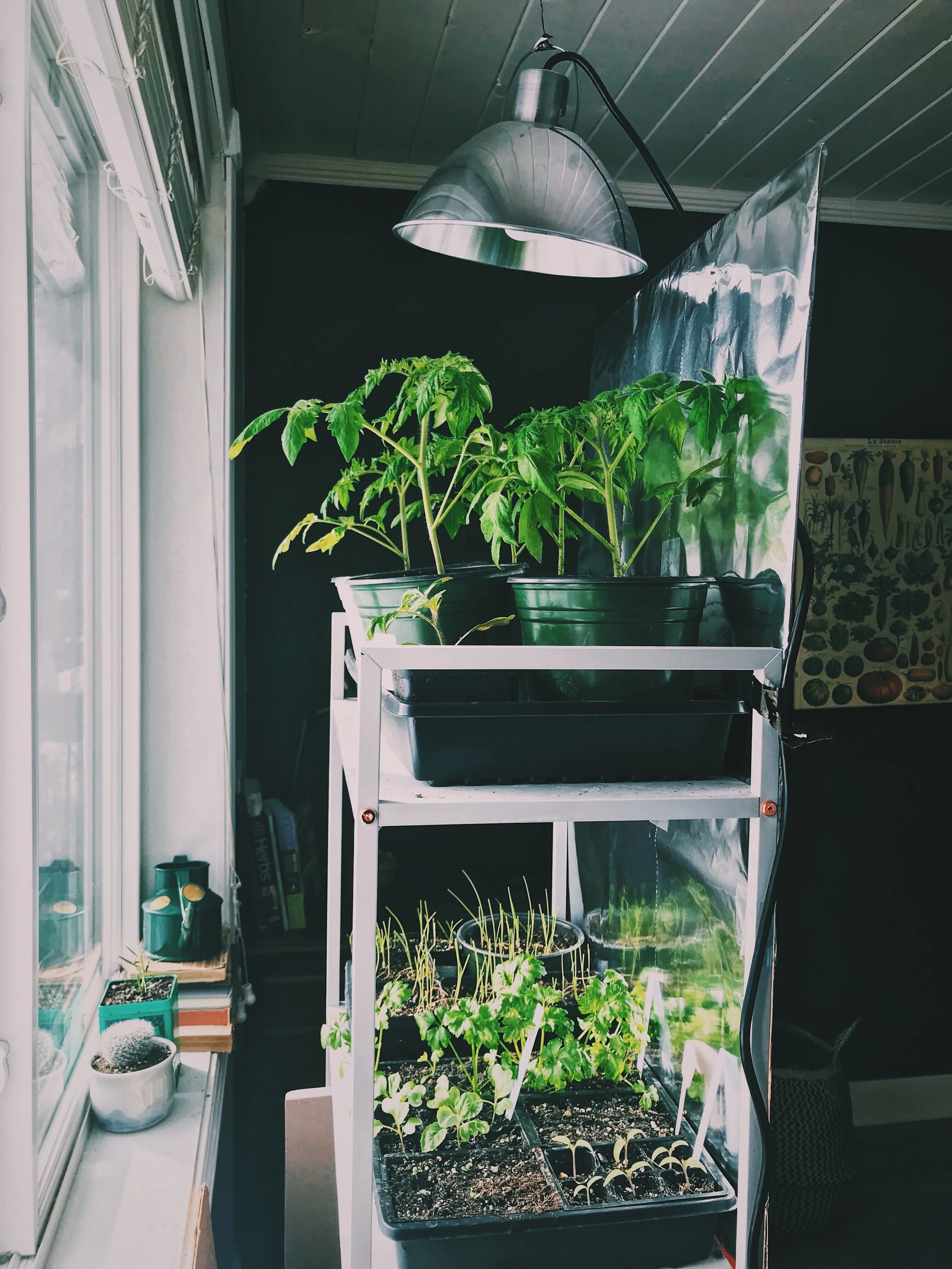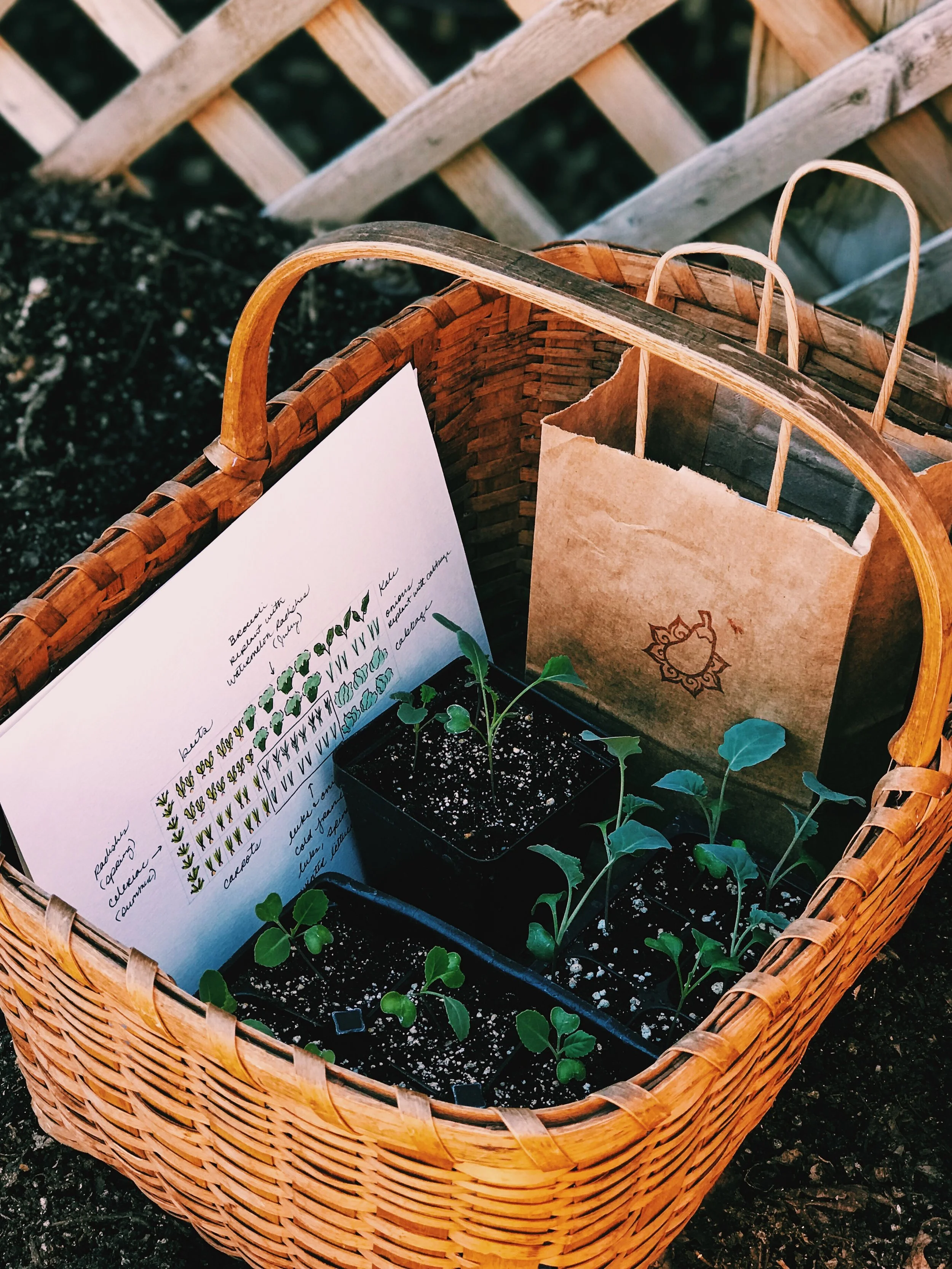Seed Starting
My favorite part about starting seeds is getting to grow plants months before the snow stops falling. I love watching the tiny plants pop their heads out of the soil, preparing for spring before there is even a robin in sight.
My Seed Starting Set Up
Over the last few years I have played with my seed starting set up. There is so much varying information out there about starting your own plants, and decided to be creative and form my own approach. This approach works well for the space I have, and to be totally transparent I am still very much learning and figuring it out as I go. I adjust the set up based on what my plants need (more light, more space, etc.) throughout the winter and spring until they are ready to be planted. It's flexible and fluid, but I have found it to be successful!
I started by trying to find the best source of light within our home. I did not want to invest a ton into plant lights, and prefer to use sunlight as the main source as much as possible. I position my starters in front of our home office window, which is east-facing. A south-facing window is ideal, but I get enough light through this window to help them grow. In addition to being near a window, I added two light fixtures - one hanging light over the top shelf and one standing light directed on the second shelf. I use 150W daylight bulbs, which I turn on only in the evenings or weekends. This gives the plants a great additional boost, but is not completely necessary, as sunlight does most of the work.
I have two plant trays set on the top two shelves of an IKEA shelving unit. Some seed trays are sold with lids or heating trays, and I don’t use either of these, as my shelving unit is located over a heating vent, keeping the plants plenty warm. For the planter pots, I purchased the small 6 pack planters with my seed tray, and the rest I repurposed from past season's 2-4" starter pots, Talenti ice cream containers, or 28oz. tomato cans (because how cute is it to plant a tomato in a tomato can?!)
Attached to the back of the shelving unit is a large reflector I created using a cardboard box wrapped in aluminum foil. It is positioned to bounce the sun from the window back onto the plants to keep them standing up instead of bending towards the window to get sun. I also covered the bottom of the top shelf with foil to help the second shelf plants get a bit more light as well.
I have also lined an IKEA greenhouse with foil and placed this in other sunny spots for plants that don’t fit on my shelving unit. It seems janky, but the foil actually does an exceptional job bouncing light back on to the plants. It is also crazy cheap, because we all have an Amazon box lying around to repurpose, as well as a pack of foil and packaging tape. (You can now call me MacGyver.)
Seeds & Soil
This year, I have decided to start all the seeds that need starting. I use a mix of Organic Seed Starting Mix and Fox Farm Potting Soil for all my starts. I also fertilize my starters with Fox Farm Liquid Fertilizer, following the product directions for seedlings.
Seed packets normally do a great job of telling you when to start them. I check when they recommend starting the seeds indoors, and they usually phrase it as '6 to 8 weeks before the last frost.' If you do a bit of googling, you can find the last predicted day of frost for your area. In Minnesota, the safest bet is to not plan on putting anything in the ground until after Mother's Day. I am a bit of a risk taker in this area, and like to plant cold hardy plants at the end of April, giving them a few weeks head start. This is fluid of course – if there is snow on the ground I won't be outside digging up the garden beds (maybe...).
Warmer weather vegetables, like tomatoes, squash and cucumbers - will say on the seed packets not to plant them in the garden until night time temperatures are above 50 degrees. I do my best to follow this to a T. I usually wait until night time temps are above 50 degrees for two weeks straight before putting them in the garden.
Onions & Tomatoes
Most seeds just require good soil, sunlight, and water to form good starters, but onions and tomatoes require a little extra care. For onions, I found the Encyclopedia Botanica Podcast Episode on Starting Onions from Seed to be super helpful! Onion seeds should be started early, between January and February, and benefit from a little trimming. Once your onion starts are 3-4 inches tall, cut them to 1-2” tall. Repeat this trimming until they are ready to plant. This trimming increases the hardiness of the onion stem, keeping them standing when planted, and help promote strong bulb growth over tall leafy growth.
Tomatoes are unique in that their roots come out of the main stem. If you look at a tomato plant stem, there are often tiny bumps all along it. These bumps are actually root nodules, getting ready to sprout from the stem – crazy right? Start by planting your tomato seeds in a small 6 pack seed starting planters until 3-4” tall. Then transplant your tomatoes to 4” seedling pots, burying the stem up until the two base leaves - these are the two leaves that come out of the ground first. The stem now buried will produce roots, giving you a stronger, well-established tomato plant.
This season, I attempted to stagger when I started my seeds, and I definitely learned a few things along the way. I started my onions and celeriac on January 21, kale and tomatoes on February 3, and lettuce, cabbage, and my herbs on March 3. My onions and celeriac are doing great, and definitely needed that much time, but I started my tomatoes and kale way too soon. I will have very large tomato plants to put into the ground, and finding the space to store them until then is going to be tricky. Live and learn right?
I am still learning a ton about seed starting, and am still making mistakes and figuring it out. I do believe that is one of the greatest part of gardening - it makes you a problem solver and when success is reached, you really feel like you accomplished something great.



















